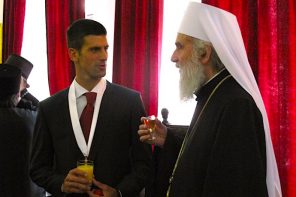In times of economic crisis, political turmoil, environmental disasters, and global conflict, Americans rely on a time-tested, highly effective collective response to the challenges we face: play ball. Though this weekend’s Super Bowl is certainly a much needed, entertaining distraction from the real world collapsing around us, it provides more than just a temporary refuge from harsh and painful realities. This annual event—as American as guns and apple pie—is a ceremonial ritual as religious as any one might find in the monotheistic traditions. Super Bowl XLIII, pitting the Pittsburgh Steelers against the Arizona Cardinals, may only be a game but, as with most sacred matters, the stakes are of ultimate importance, with the material and spiritual investments likewise incalculable.
The Sacred and the Super Bowl, Play and Religious Life
Let’s start with one of the most memorable moments in the history of the game—the nipple incident. When Janet Jackson’s exposed breast and starburst-covered nipple flashed for seconds during the halftime celebration at Super Bowl XXXVIII in February 2004, the sacred dimensions of sports and the high stakes of play, were put into high relief in the uproar that followed. This championship battle between the AFC’s New England Patriots and NFC’s Carolina Panthers was overshadowed by a bare female breast, a decidedly unusual sight at the big game, even for viewers who are repeatedly exposed to female cleavage, bouncing breasts, camera shots angled from the ground looking up skirts, and other images associated with the female cheerleaders—a staple of the game. Although male nudity was a common feature of the ancient Greek games, where bodily control, self-discipline, and military ideals reigned supreme, female nudity was not. Women watched the competition from the stands and participated in the surrounding religious and civic festivities. The male athletic body, nude in ancient Greece, fully clad with extra padding and a helmet in contemporary American football, dominates the field in sports and, though competition may verge on the erotic for some (both then and now), it is generally framed in militaristic rather than sexual terms.
The breast crossed a line for many viewers and spectators, who were stunned at what was frequently perceived to be an intentionally provocative act. Staying within the lines, playing by the rules, maintaining boundaries that ensure order—these are essential preconditions for sports play, as well as for military and religious institutions. For each of these highly disciplined, body-monitoring activities, lines, rules, and boundaries are established around bodies in part because of the human propensity to cross, break, and transgress them. These transgressions create moments that contravene expectations of order and stability, structure and control, but there are also scandalous and thrilling breakdowns which captivate, or even enrapture, a public routinely salivating for people who go too far.
Violence between players on the field, a fight between fans in the stands, the growing scourge of steroids and other performance-enhancing drugs, gambling scandals; these and other ignominious sports stories have moral import—as entertaining or as tragic as they may be—for larger social communities with members whose ethical formation and principles are shaped as much by play on the field as by words in a church. Indeed, morals are tested on these playing fields, where the temptations to transgress, deceive, and cheat are so compelling for players and sensational for fans that every game is a ritual reminder and reaffirmation of rules and laws, boundaries and prohibitions that will, out of necessity, break down. The well-regulated male body in competition is a morally-charged, ethically-challenged body that is, however, only one piece in the larger religious complex of sports.
No doubt the moral outrage that erupted upon seeing Jackson’s breast reverberated across all kinds of communities. Christians, Jews, and Muslims, Hindus and Buddhists, even atheists and pagans (well, maybe not pagans) vigorously complained about such an offensive act, especially as the halftime show is considered to be a shared, family viewing experience, with vulnerable children who can easily be led morally astray. Their fury may have derived from a New Testament understanding of a woman’s place; or it might have emerged from a strong political commitment to what has come to be known as “family values”; or, it may simply be based on a less tolerant understanding of the line separating decency from indecency. The range of people who complained and the impact of the collective crisis and debate about the nipple also point to a deeper significance, one that is especially pronounced during this event. The breast was clearly matter out of place. For a brief moment this particular part of Janet Jackson’s anatomy illustrated the very inviolability of the Super Bowl, an event as sacred and ritually fulfilling as any holy day marked off on religious calendars around the world.
“Sentimental Education”
It’s a cliche to say that the Super Bowl is a media circus and an advertising godsend, but it is also, as many observers and participants have claimed, a momentous event embedded in a religious culture tied to sports generally and to football specifically. A litany of remembered moments and memorable icons outfit the landscape, like Joe Namath’s famous prediction of a Jets victory over the Colts, or the person of Vince Lombardi who stands as a ghostly beacon in football lore. But in addition to the money and glory associated with the game, symbolic and ritual orders are also reaffirmed, especially at the very center of the festivities—the middle of the field and in the middle of the game—and at the very end of a long season of conflict and strife, risk-taking, and chance for the teams involved.
Flags flying, fans behaving, time passing, authorities presiding, athletes competing—the game is predicated on familiar sights and sounds, movements and interactions, a predictable order of things, in sports perhaps more so than in the daily world outside of sports. Yet the very nature of play is inherently unpredictable and volatile, and therefore ripe for emotionally-driven, spiritually-hungry humans just waiting for something memorable and meaningful to happen. Although some see it as simply a national, secular holiday, the Super Bowl plays out in American culture year after year as a religious event, sacrosanct and celebratory in the lives of millions of fans from all faith traditions and philosophical schools, including believers and non-believers, God-fearing fundamentalists and free-spirited lefties.
Although worlds away from Balinese cockfighting, the Super Bowl, and football generally, is a revealing social text that expresses a story that Americans like to “tell themselves about themselves.” Eminent anthropologist Clifford Geertz sees this interpretive function in the social activities and symbolic systems surrounding the popular Balinese sport which cannot simply be characterized as a rite or a pastime. Geertz’s analysis of cockfighting can be applied to a “read” of the Super Bowl: “What the [Super Bowl] says it says in a vocabulary of sentiment—the thrill of risk, the despair of loss, the pleasure of triumph. Yet what it says is not merely that risk is exciting, loss depressing, or triumph gratifying, banal tautologies of affect, but that it is of these emotions, thus exampled, that society is built and individuals are put together.”
This “sentimental education,” to continue with Geertz’s insightful language, communicated through the emotional January ritual is culturally revealing. But it is a distinctively religious story as well, with or without God in the action, that encompasses and resolves—however temporarily and precariously—a variety of unresolved social realities outside of the field of play, such as the persistence of violence and group conflict, confusion around gender divisions and sexual expression, and hypocrisy and double standards in traditional religions where winners and losers do not always represent a just, moral order.
Miniature Gardens of Eden
A time for carousing and partying, praying and gambling, the Super Bowl and surrounding festivities arouse passions and behaviors that demonstrate deep life commitments and valuable stakes. Janet Jackson flashing her breast is one way to identify how much is on the line, but the somber, solemn halftime show of Super Bowl XXXVI, just months after 9/11, also captures and reinforces the stakes of the game, as well as the centrality of the ritual in American life. With the names of the dead scrolling behind them, U2 performed on a heart-shaped stage surrounded by patriotic symbols of the American nation—a poignant, heartbreaking image in a night full of ritual acts for the dead and social solidarity, including the raising of a World Trade Center flag by a group of New York City firemen.
According to some reports, the resumption of life—in particular, forms of play like professional sports—after that fatal and fateful day had healing power and religious meaning. In a September 2002 USA Today article accompanied by an image of the flag-raising, journalist Erik Brady wrote that “Ballparks and stadiums became town squares where much of the ritual of public healing took place… Ballparks became home to sacramental ceremony,” places that he later refers to “miniature gardens of Eden.” This Eden does not require the creation of God but instead has sacred vitality on its own terms, a meaningful space where the religious values and valences spring from the play on, and rituals surrounding, the field itself.
The Super Bowl is a holy day as much as it is a sports event, holy as a sacred carnival dedicated to, and undergirded by, consumerism and masculinity, nationalism and play. But at bottom, as popular culture scholar Jack Santino has proposed, the game is really about the desire for power and empowerment.
Physical power of athletes on the field, strategic power of coaches, corporate power in the stadium suites and celebrated advertisements, iconic power for performers at halftime, and fan empowerment for individuals whose identities merge with their team’s and have awe-inspiring experiences watching them play; taken together, the Super Bowl exudes sacred powers that cannot be reduced to purely material forms tied to physical strength, financial might, or alcoholic inebriation; nor can this power be allied only with God, a familiar force called upon by athletes in the will to overpower opponents and by fans in search of saving grace before the final seconds tick off the clock.
Instead, the big game has empowering, memorable ritual vitality in the lives of participants and spectators whether God accompanies them to the game or not; it possesses value-laden drama in the game itself but also in the pre- and post-game activities, all of which teach moral lessons that transcend the game; and it assumes mythological status in the popular imagination where players (and occasionally whole teams) can enter the pantheon of immortal heroes remembered and idolized as not quite God but more than man, as super human exemplars engaged in consequential defining moments that will live on in memory—and NFL Films. Pass the beer. Go Cardinals!




